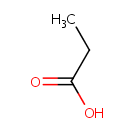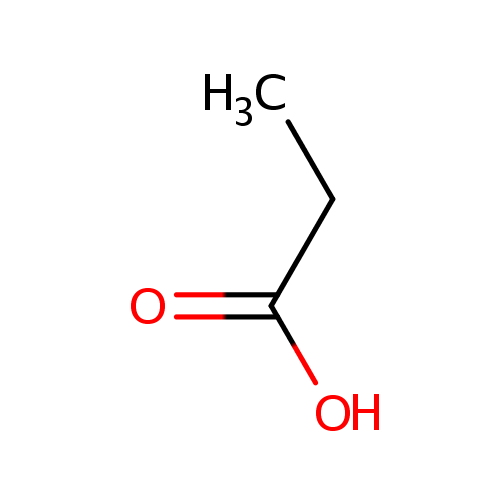
Propionic acid (PAMDB000098)
| Record Information | ||||||||||||||||||||||||||||||||||||||||||||||||||||||||||
|---|---|---|---|---|---|---|---|---|---|---|---|---|---|---|---|---|---|---|---|---|---|---|---|---|---|---|---|---|---|---|---|---|---|---|---|---|---|---|---|---|---|---|---|---|---|---|---|---|---|---|---|---|---|---|---|---|---|---|
| Version | 1.0 | |||||||||||||||||||||||||||||||||||||||||||||||||||||||||
| Update Date | 1/22/2018 11:54:54 AM | |||||||||||||||||||||||||||||||||||||||||||||||||||||||||
| Metabolite ID | PAMDB000098 | |||||||||||||||||||||||||||||||||||||||||||||||||||||||||
| Identification | ||||||||||||||||||||||||||||||||||||||||||||||||||||||||||
| Name: | Propionic acid | |||||||||||||||||||||||||||||||||||||||||||||||||||||||||
| Description: | Propionic acid (PA) is a naturally-occurring carboxylic acid with chemical formula CH3CH2COOH. It is a clear liquid with a pungent odor. The anion CH3CH2COO | |||||||||||||||||||||||||||||||||||||||||||||||||||||||||
| Structure | ||||||||||||||||||||||||||||||||||||||||||||||||||||||||||
| Synonyms: |
| |||||||||||||||||||||||||||||||||||||||||||||||||||||||||
| Chemical Formula: | C3H6O2 | |||||||||||||||||||||||||||||||||||||||||||||||||||||||||
| Average Molecular Weight: | 74.0785 | |||||||||||||||||||||||||||||||||||||||||||||||||||||||||
| Monoisotopic Molecular Weight: | 74.036779436 | |||||||||||||||||||||||||||||||||||||||||||||||||||||||||
| InChI Key: | XBDQKXXYIPTUBI-UHFFFAOYSA-N | |||||||||||||||||||||||||||||||||||||||||||||||||||||||||
| InChI: | InChI=1S/C3H6O2/c1-2-3(4)5/h2H2,1H3,(H,4,5) | |||||||||||||||||||||||||||||||||||||||||||||||||||||||||
| CAS number: | 79-09-4 | |||||||||||||||||||||||||||||||||||||||||||||||||||||||||
| IUPAC Name: | propanoic acid | |||||||||||||||||||||||||||||||||||||||||||||||||||||||||
| Traditional IUPAC Name: | propanoic acid | |||||||||||||||||||||||||||||||||||||||||||||||||||||||||
| SMILES: | CCC(O)=O | |||||||||||||||||||||||||||||||||||||||||||||||||||||||||
| Chemical Taxonomy | ||||||||||||||||||||||||||||||||||||||||||||||||||||||||||
| Taxonomy Description | This compound belongs to the class of organic compounds known as carboxylic acids. These are compounds containing a carboxylic acid group with the formula -C(=O)OH. | |||||||||||||||||||||||||||||||||||||||||||||||||||||||||
| Kingdom | Organic compounds | |||||||||||||||||||||||||||||||||||||||||||||||||||||||||
| Super Class | Organic acids and derivatives | |||||||||||||||||||||||||||||||||||||||||||||||||||||||||
| Class | Carboxylic acids and derivatives | |||||||||||||||||||||||||||||||||||||||||||||||||||||||||
| Sub Class | Carboxylic acids | |||||||||||||||||||||||||||||||||||||||||||||||||||||||||
| Direct Parent | Carboxylic acids | |||||||||||||||||||||||||||||||||||||||||||||||||||||||||
| Alternative Parents | ||||||||||||||||||||||||||||||||||||||||||||||||||||||||||
| Substituents |
| |||||||||||||||||||||||||||||||||||||||||||||||||||||||||
| Molecular Framework | Aliphatic acyclic compounds | |||||||||||||||||||||||||||||||||||||||||||||||||||||||||
| External Descriptors |
| |||||||||||||||||||||||||||||||||||||||||||||||||||||||||
| Physical Properties | ||||||||||||||||||||||||||||||||||||||||||||||||||||||||||
| State: | Liquid | |||||||||||||||||||||||||||||||||||||||||||||||||||||||||
| Charge: | -1 | |||||||||||||||||||||||||||||||||||||||||||||||||||||||||
| Melting point: | -20.7 °C | |||||||||||||||||||||||||||||||||||||||||||||||||||||||||
| Experimental Properties: |
| |||||||||||||||||||||||||||||||||||||||||||||||||||||||||
| Predicted Properties |
| |||||||||||||||||||||||||||||||||||||||||||||||||||||||||
| Biological Properties | ||||||||||||||||||||||||||||||||||||||||||||||||||||||||||
| Cellular Locations: | Cytoplasm | |||||||||||||||||||||||||||||||||||||||||||||||||||||||||
| Reactions: | Propionyl-CoA + Succinic acid > Propionic acid + Succinyl-CoA Water + NADP + Propanal >2 Hydrogen ion + NADPH + Propionic acid Adenosine triphosphate + Coenzyme A + Propionic acid > ADP + Phosphate + Propionyl-CoA Coenzyme A + Propionic acid + Adenosine triphosphate > Propionyl-CoA + Pyrophosphate + Adenosine monophosphate Adenosine triphosphate + Propionic acid <> ADP + Propanoyl phosphate Adenosine diphosphate + propanoyl phosphate + ADP + Propanoyl phosphate > Adenosine triphosphate + Propionic acid Propionic acid + Adenosine triphosphate + Coenzyme A > Propionyl-CoA + Adenosine monophosphate + Pyrophosphate + Propionyl-CoA Succinic acid + Propionyl-CoA + Propionyl-CoA > Propionic acid + Succinyl-CoA + Succinyl-CoA | |||||||||||||||||||||||||||||||||||||||||||||||||||||||||
| Pathways: | ||||||||||||||||||||||||||||||||||||||||||||||||||||||||||
| Spectra | ||||||||||||||||||||||||||||||||||||||||||||||||||||||||||
| Spectra: | ||||||||||||||||||||||||||||||||||||||||||||||||||||||||||
| References | ||||||||||||||||||||||||||||||||||||||||||||||||||||||||||
| References: |
| |||||||||||||||||||||||||||||||||||||||||||||||||||||||||
| Synthesis Reference: | Zhan, Jianghong; Meng, Wei; Gong, Tao; Huang, Fen-sheng. Preparation of propionic acid by propionaldehyde oxidation. Shihua Jishu Yu Yingyong (2005), 23(6), 421-423. | |||||||||||||||||||||||||||||||||||||||||||||||||||||||||
| Material Safety Data Sheet (MSDS) | Download (PDF) | |||||||||||||||||||||||||||||||||||||||||||||||||||||||||
| Links | ||||||||||||||||||||||||||||||||||||||||||||||||||||||||||
| External Links: |
| |||||||||||||||||||||||||||||||||||||||||||||||||||||||||
Enzymes
- General function:
- Involved in kinase activity
- Specific function:
- Involved in the activation of acetate to acetyl CoA and the secretion of acetate. During anaerobic growth of the organism, this enzyme is also involved in the synthesis of most of the ATP formed catabolically
- Gene Name:
- ackA
- Locus Tag:
- PA0836
- Molecular weight:
- 42.4 kDa
Reactions
| ATP + acetate = ADP + acetyl phosphate. |
| ATP + propanoate = ADP + propanoyl phosphate. |
- General function:
- Involved in acetate-CoA ligase activity
- Specific function:
- Enables the cell to use acetate during aerobic growth to generate energy via the TCA cycle, and biosynthetic compounds via the glyoxylate shunt. Acetylates CheY, the response regulator involved in flagellar movement and chemotaxis
- Gene Name:
- acs
- Locus Tag:
- PA0887
- Molecular weight:
- 71.8 kDa
Reactions
| ATP + acetate + CoA = AMP + diphosphate + acetyl-CoA. |
- General function:
- Involved in oxidoreductase activity
- Specific function:
- Catalyzes the NADP-dependent oxidation of diverse aldehydes such as chloroacetaldehyde, acetaldehyde, propionaldehyde, benzaldehyde, mafosfamide, 4- hydroperoxycyclophosphamide. Its preferred substrates are acetaldehyde and chloroacetaldehyde
- Gene Name:
- aldB
- Locus Tag:
- PA1984
- Molecular weight:
- 54.9 kDa
Transporters
- General function:
- Involved in proline:sodium symporter activity
- Specific function:
- Catalyzes the sodium-dependent uptake of extracellular L-proline. This protein is also capable of using lithium as the transport cation. Also catalyzes the uptake of propionate
- Gene Name:
- putP
- Locus Tag:
- PA0783
- Molecular weight:
- 54.4 kDa

